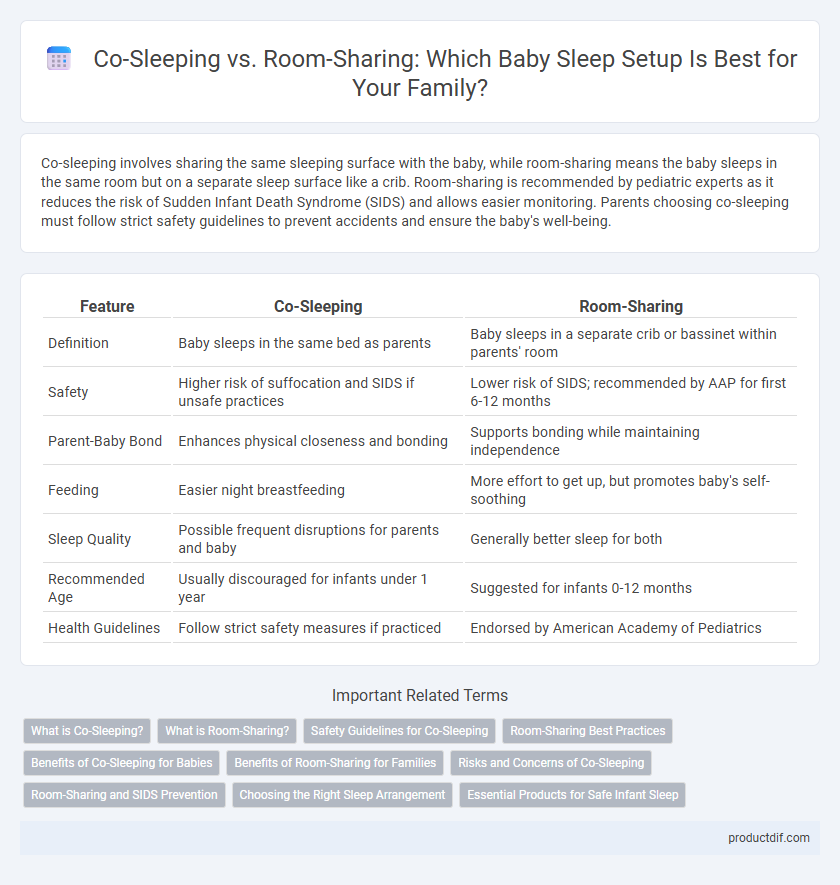Co-sleeping involves sharing the same sleeping surface with the baby, while room-sharing means the baby sleeps in the same room but on a separate sleep surface like a crib. Room-sharing is recommended by pediatric experts as it reduces the risk of Sudden Infant Death Syndrome (SIDS) and allows easier monitoring. Parents choosing co-sleeping must follow strict safety guidelines to prevent accidents and ensure the baby's well-being.
Table of Comparison
| Feature | Co-Sleeping | Room-Sharing |
|---|---|---|
| Definition | Baby sleeps in the same bed as parents | Baby sleeps in a separate crib or bassinet within parents' room |
| Safety | Higher risk of suffocation and SIDS if unsafe practices | Lower risk of SIDS; recommended by AAP for first 6-12 months |
| Parent-Baby Bond | Enhances physical closeness and bonding | Supports bonding while maintaining independence |
| Feeding | Easier night breastfeeding | More effort to get up, but promotes baby's self-soothing |
| Sleep Quality | Possible frequent disruptions for parents and baby | Generally better sleep for both |
| Recommended Age | Usually discouraged for infants under 1 year | Suggested for infants 0-12 months |
| Health Guidelines | Follow strict safety measures if practiced | Endorsed by American Academy of Pediatrics |
What is Co-Sleeping?
Co-sleeping refers to the practice where parents and their baby share the same sleeping surface, such as a bed, to promote bonding and ease nighttime breastfeeding. This method contrasts with room-sharing, where the baby sleeps in a separate crib or bassinet within the parents' room, reducing risks associated with bed-sharing. Understanding co-sleeping helps parents make informed decisions for safe sleep environments that support infant development and parental comfort.
What is Room-Sharing?
Room-sharing involves placing the baby's crib or bassinet in the parents' bedroom, allowing close proximity without sharing the same sleeping surface. This practice supports easier nighttime feeding and monitoring while reducing the risk of Sudden Infant Death Syndrome (SIDS). Pediatric experts recommend room-sharing for at least the first six months to promote infant safety and parental convenience.
Safety Guidelines for Co-Sleeping
Co-sleeping requires strict adherence to safety guidelines such as using a firm mattress, removing pillows and blankets, and ensuring the baby sleeps on their back to reduce the risk of Sudden Infant Death Syndrome (SIDS). Avoiding co-sleeping on couches or armchairs and keeping the sleep surface free from gaps where the baby could become trapped are critical safety measures. Parents should also avoid co-sleeping if they are smokers, have consumed alcohol, or are excessively tired to maintain a safe sleep environment for the infant.
Room-Sharing Best Practices
Room-sharing promotes safer sleep by placing the baby's crib or bassinet in the parents' bedroom, reducing the risk of Sudden Infant Death Syndrome (SIDS). Using a firm, flat sleep surface free of pillows, blankets, and toys enhances safety while allowing parents to easily monitor and soothe their baby. Experts recommend maintaining a consistent sleep environment with appropriate temperature control and avoiding bed-sharing to ensure optimal infant safety and comfort.
Benefits of Co-Sleeping for Babies
Co-sleeping promotes stronger emotional bonding and secure attachment between baby and parent, enhancing the infant's sense of safety and comfort. This practice often leads to improved breastfeeding frequency and duration due to easier nighttime access, supporting better infant nutrition and development. Moreover, co-sleeping can regulate the baby's breathing and body temperature, reducing the risk of Sudden Infant Death Syndrome (SIDS) in certain contexts.
Benefits of Room-Sharing for Families
Room-sharing helps families maintain close proximity, promoting easier nighttime breastfeeding and quicker response to baby's needs, which can enhance infant safety and sleep quality. Studies show that keeping the baby's crib in the parents' bedroom reduces the risk of Sudden Infant Death Syndrome (SIDS) by up to 50%, according to the American Academy of Pediatrics. This arrangement fosters bonding and peace of mind for parents while supporting better sleep patterns for the entire family.
Risks and Concerns of Co-Sleeping
Co-sleeping has been linked to an increased risk of Sudden Infant Death Syndrome (SIDS) due to potential suffocation hazards from bedding and parental overlay. Experts caution that soft mattresses, pillows, and adult blankets can contribute to accidental strangulation or overheating during co-sleeping. Pediatric guidelines recommend room-sharing without bed-sharing as a safer alternative to support infant monitoring while minimizing risks.
Room-Sharing and SIDS Prevention
Room-sharing, where the baby sleeps in the same room but on a separate surface, significantly reduces the risk of Sudden Infant Death Syndrome (SIDS) by promoting close monitoring without bed-sharing hazards. According to the American Academy of Pediatrics, room-sharing lowers SIDS risk by up to 50% by enabling parents to quickly respond to the infant's needs while maintaining a safe sleep environment. Using a dedicated crib or bassinet in the parents' bedroom supports better breathing regulation and decreases the likelihood of accidental suffocation or overheating.
Choosing the Right Sleep Arrangement
Choosing the right sleep arrangement for infants involves evaluating the benefits of co-sleeping versus room-sharing, both endorsed by pediatricians for promoting safe sleep and bonding. Co-sleeping allows close physical proximity, potentially enhancing breastfeeding and soothing, while room-sharing keeps the baby in a separate crib within the parents' bedroom, reducing the risk of Sudden Infant Death Syndrome (SIDS). Prioritizing safe sleep environments with firm mattresses, avoiding soft bedding, and following guidelines from organizations like the American Academy of Pediatrics ensures optimal infant safety regardless of the sleep setup.
Essential Products for Safe Infant Sleep
Essential products for safe infant sleep include firm, flat mattresses, breathable crib sheets, and wearable blankets designed for temperature regulation. Both co-sleeping and room-sharing benefit from safety-approved bassinets or co-sleepers with secure sides to prevent falls and suffocation risks. Utilizing baby monitors with movement detection and white noise machines can further enhance monitoring and create a calming sleep environment for infants.
Co-Sleeping vs Room-Sharing Infographic

 productdif.com
productdif.com